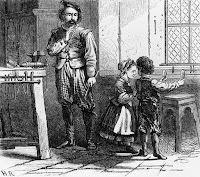“With increasing distance, our knowledge fades and fades rapidly. Eventually, we reach the dim boundary—the utmost limits of our telescopes. There, we measure shadows, and we search among ghostly errors of measurement for landmarks that are scarcely more substantial. The search will continue. Not until the empirical resources are exhausted, need we pass on to the dreamy realms of speculation.”
Edwin Hubble, The Realm of the Nebulae (1936)
- The Telescope with which Galileo explored the solar system is held at the Museo Della Scienza, Florence.
- These observations - based sepia wash studies of phases of the moon were executed by Galileo in 1609
The legend goes that, playing one day in their father's spectacle shop, two Dutch children realized that if they looked through both a concave lens close to their eye and a concave lens held at arm's length, the local church tower was greatly magnified.
Their father, Hans Lippershey (circa 1570 -1619), then mounted the two lenses in a tube and tried to sell the device to the Dutch Army. Whether the credit for this invention should go tho Lippershey or to, for example, Zacharius Janssen or Jacob Metius, or even the Englishman Leonard Digge, has become a matter of considerable debate. At the very least, Lippershey is generally credited with popularizing the device and creating and disseminating designs for the first practical telescope. Soon similar instruments, known as "dutch Trunks," were appearing all over Europe.
The Italian astronomer and Physicist Galileo Galilei heard about the new device when he was in Venice in May 1609. Returning to his university in nearby Padua, he made a telescope that magnified by about one-tenth of a degree. Using this, he discovered that the sun had spots, Jupiter was accompanied by four satellites, Venus had Phases, and the moon was mountainous. These results he published in March 1610 in his work, Siderius Nuncius (The Sidereal Messenger).
Telescopic Astronomy never looked back. By 1611, the German astronomer Johannes Kepler was using a telescope consisting of two convex lenses, an instrument that gave greater Magnification but an inverted image.

In 1668 the English genius Sir Isaac Newton invented the reflecting telescope, which uses a curved mirror rather than a large lens to collect and focus light, thus eliminating the problem of severe chromatic aberration.







No comments:
Post a Comment